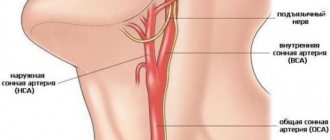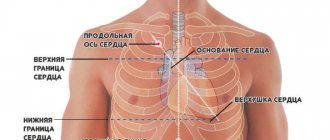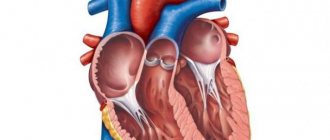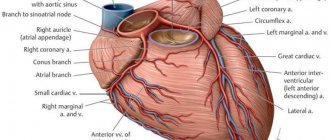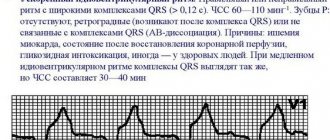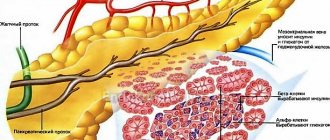Examinations and operations on the main arteries of the lower extremities are successfully performed in the clinic of the Tver Medical University. Examinations and operations can be performed free of charge for all patients with a compulsory medical insurance policy, and you can be registered in any region of Russia and even be a foreign citizen.
If you need surgery on the femoral artery, or consult a doctor, make an appointment by calling:
- 8 (Research Institute “Phlebology”, Tver, 2nd Krasina St. 49)
- 8 (University Clinic, Tver, Peterburgskoye Highway, 115 building 2)
Which leg arteries are most often affected?
The arteries supplying blood to the lower extremities can be divided into 3 groups or floors, depending on location:
- aorta and iliac arteries
- femoral arteries
- arteries of the leg and foot
The surgeon most often deals with operations on the femoral arteries. These include the common, superficial and deep femoral arteries.
Main branches
A series of connections extend from the main vessel. Each of them provides blood supply to a separate area and performs certain functions:
- Superficial epigastric artery. Transports blood to the external oblique muscle of the abdomen and the skin of the anterior wall of the peritoneum. It goes from the bottom of the inguinal ligament up the anterior abdominal wall to the umbilical ring. Near the navel it connects with the superior epigastric artery.
- Superficial femoral. Responsible for nourishing the groin muscles, lymph nodes and skin. Departs from the epigastric or from the outer wall of the femoral artery. It runs along the inguinal ligament to the anterior iliac spine.
- External genital arteries. Their number varies from 2 to 3. They are directed medially, bending around the anterior and posterior periphery of the femoral vein. They also include a large number of smaller branches that are located in the scrotum in men, the labia in women and above the pubis.
- Inguinal branches. Provides a flow of nutrients and blood to the lymph nodes and skin. They originate from the external genital arteries in the form of small stems. Then they pass through the fascia lata of the thigh.
- Deep artery of the femur. The largest of all branches, which consists of a whole network of vessels. It starts 3-4 cm below the inguinal ligament and ends in the lower third of the thigh, between the long and large adductor muscles. Arteries depart from it - lateral, medial, perforating, as well as small capillaries. They promote normal blood circulation in muscles, joints, and deep layers of the epidermis.
- Descending knee. A long vessel that can arise either directly from the femoral artery or from the lateral one. It ends in the thickness of the knee muscles and the capsule of the knee joint. It has branches - articular and subcutaneous.
Since the deep femoral artery is the main element of the blood circulation of the femoral artery, the peculiarities of its structure should be taken into account. Several more vessels depart from each of its branches:
- Medial artery. Its continuation is the ascending, transverse, deep branches and the branch of the acetabulum.
- Lateral. It arises from the outer wall of the deep artery and divides at the intersection with the trochanter of the femur. There the ascending, descending and transverse branches depart from it.
- Perforated arteries. Located at different levels from the main artery. In the area where the adductor muscles attach to the femur, they move to the back of the thigh. They supply the adductor, semimembranosus, semitendinosus, and biceps muscles.
Disruption of blood flow in at least one channel is fraught with serious consequences for the entire vascular system. Ligaments, external genitalia, and lower limbs also suffer due to lack of oxygen and nutrients.
The Scarpian or femoral triangle is formed by the superficial epigastric, superficial and genital arteries. Its height is 15-20 cm.
What operations are performed on the femoral arteries?
Operations are divided
By way of execution:
- Open (prosthetics, bypass surgery, angioplasty, etc.). A skin incision is made, the vessel is exposed, and the surgeon performs the operation under visual control. Most often, bypass surgery involves replacing a section of an artery with the body’s own vein or a synthetic prosthesis. In this case, the blood bypasses the affected area.
- Endovascular (balloon angioplasty, stenting, etc.). Instruments are inserted into the artery through a puncture of the skin, and under X-ray control using an angiograph machine, the surgeon performs an operation: a special balloon expands the lumen of the artery, and, if necessary, places a stent. The image is displayed on the monitor.
According to the urgency of implementation:
- Emergency – performed for acute pathologies (thrombosis, vessel injury, etc.) within several hours after the onset of the disease.
- Planned – for chronic diseases (atherosclerosis, arterial aneurysm, etc.) are performed as planned.
Features of thrombosis
Iliac vein thrombosis is a common pathology. It consists in the formation of blood clots in the lower extremities. The disease is dangerous because it can lead to pulmonary embolism. If the clot breaks off, it will go directly to the vessels of the lungs. As a result, the patient may die!
Why does pathology develop?
Thrombosis is a consequence of:
- Reductions in hemodynamic velocity.
- Disorders of blood clotting processes.
- Damage to vascular walls.
There are also some triggers.
Many patients with thrombosis:
- They were kept in bed for a long time.
- Suffered various injuries.
Also, pathology developing in the veins is provoked by:
- Infectious diseases.
- Long-term use of hormonal drugs.
- Vascular compression syndrome.
- Pelvic tumors.
Thrombosis often occurs during pregnancy.
The main symptoms of iliac vein pathology include:
- Severe swelling. Legs usually swell.
- Changes in skin color. The upper thighs and pelvic cavity may turn blue or purplish red.
- The appearance of small brown dots.
- Pain. Typically, it is concentrated in the legs or groin. Moreover, over time the pain intensifies. If at first the patient feels it only during exercise, then at rest and even at night.
- Increased body temperature.
Thrombosis develops gradually.
There are several stages of pathology.
Among them:
- Prodromal. This stage of thrombosis is always associated with severe pain. They can concentrate both in the upper third of the thighs and in the groin area. In some cases, discomfort occurs in the lower back, in the abdominal area, on the entire side of the limb that is affected by the pathology. As a rule, the pain is aching and dull. In addition, with pathology of the iliac region, an increase in temperature is noted.
- Stage of pronounced clinical symptoms. It proceeds even more pronounced. The patient may experience swelling, changes in skin color, and pain. Thrombosis provokes discomfort in the hips, groin, and lower abdomen. Some patients complain of pain in the sacrum and even the calf muscle. The discomfort seems to spread, spreading over ever larger areas. The situation with edema is similar. They can start from the groin fold and extend to the ankle. In advanced cases, numbness occurs.
Request a call back Get a free consultation
What operations are performed for atherosclerosis?
Atherosclerosis is the most common cause of chronic ischemia of the lower extremities. Atherosclerosis leads to narrowing (stenosis) or blockage (occlusion) of a vessel (for more details, see the section “Atherosclerosis”). Surgeries for atherosclerosis are aimed at restoring blood flow:
Endovascular: under X-ray control, the lumen of the vessel is expanded using special balloons; if necessary, a stent is placed, which acts as a cylindrical frame and ensures patency of the artery.
During open operations, vascular remodeling occurs under visual control.
Femoral artery replacement or bypass surgery. The name of the prosthesis or shunt depends on the method of its application (suturing). In this case, the essence is the same - the artery is replaced with one’s own vein or a synthetic prosthesis.
Angioplasty is the remodeling of blood vessels using the artery’s own tissue, as well as using a patch from one’s own vein or synthetic material. The most common procedure performed is profundoplasty – remodeling of the deep femoral artery.
How is pathology diagnosed?
To detect thrombosis, the following studies are performed:
- Duplex scanning. This technique for assessing the condition of the vein allows you to determine hemodynamics.
- X-ray of blood vessels. This technique is performed using contrast. It makes it possible to study the condition of each vein that may be blocked by a blood clot.
If the patient does not tolerate contrast studies, vascular scanning is performed using radionuclide techniques.
Which surgery is better?
Each operation has its own indications and contraindications. The method of surgical treatment is chosen by the doctor based on many different factors, taking into account not only ultrasound and angiography data, but also the patient’s health status, the presence of concomitant diseases, age, etc. Some patients may require a combination of different techniques, such as stenting one section of the artery and replacing another. Such operations are called “hybrid”.
Surgery on the great vessels is one of the most common operations in the world, which has saved the lives and preserved the health of millions of people.
Online consultations (Skype, Viber, Whats App)
Sign up for a consultation
How is the treatment carried out?
Thrombosis is a disease that can be successfully treated today. It is only important to choose the right method.
Popular ones include:
- Endovascular thrombectomy.
This technique involves performing surgery on a vein. It comes down to removing blood clots with a catheter. The vein itself is preserved.
Before the intervention, the blocked area is detected by angiography. During the operation, the damaged veins are cut along the edge of the formation. An empty catheter with a balloon is inserted into the incision. After this, the balloon is filled with saline solution. The product is pulled out along with the blood clot. The manipulation is carried out several times. Thanks to this, specialists are able to achieve maximum cleaning of the vessel.
Non-radical thrombectomy can be:
- Aspiration. In this case, blood clots are removed through the catheter with a syringe. The technique does not always give the desired result. This is due to the fact that it is impossible to remove all clots with a syringe.
- Rheolytic. In this case, new blood clots are removed by puncture of individual sections of the vascular bed. Special catheters are used.
Thrombolysis is also performed. This technique involves injecting special substances into the blood clot. They effectively soften the clot. This procedure is quite lengthy. In addition, it is highly antigenic.
- Balloon dilatation.
This method of combating thrombosis involves dilating the affected vessels by applying a special balloon to them. The progress of the balloon is carefully controlled. Additionally, special drugs are used. They reduce the risk of rapid blood clotting. Narrowed vessels can be dilated in 80% of patients using this technique. Balloon dilatation can be performed when any arteries are narrowed.
Today, other methods are used to combat thrombosis. Experts prefer minimally invasive interventions.
This is due to their advantages such as:
- Possibility of outpatient treatment. Intervention for thrombosis does not require several days of hospitalization.
- No need for anesthesia. It is possible to restore the patency of the iliac vein even with local anesthesia. In this case, the patient will not experience pain or severe discomfort.
- No operational risks. This advantage is due to the fact that the patient is not put under anesthesia. The patient can follow all the doctor’s commands, talk about his condition, and answer questions from specialists.
- Reduced likelihood of complications. Unpleasant consequences after treatment occur in isolated cases.
- High efficiency. In most cases, vein thrombosis is eliminated. The patient forgets about the problems that tormented him. Large veins, visible to the naked eye, no longer bother the patient and do not contribute to the emergence of numerous complexes.
Recovery after intervention
Thrombosis imposes a lot of restrictions on the life of any patient. Often patients whose veins are blocked by blood clots cannot even move normally. Recovery after surgery for thrombosis will not be associated with restrictions! Almost immediately after the intervention, the patient will be able to return to the usual lifestyle that he led before the illness. Anyone can forget about the problems thrombosis caused.
Of course, during rehabilitation you will need to:
- Follow the recommendations of your doctor.
- Increase the amount of liquid in your diet.
- Monitor the condition of the veins.
- Get checked regularly.
- Take some medications.
You will not be limited in mobility! After vein surgery, you do not need to remain in bed for long periods of time.
Request a call back Get a free consultation
Is it possible to carry out adequate prevention of the disease?
Yes! But not always and not everyone succeeds.
To prevent thrombosis it is necessary:
- Constantly monitor your diet and fluid intake.
- Be sure to have a good rest.
- Take regular walks.
- Adhere to a healthy lifestyle.
Even if vein pathology has already occurred, its further development can be prevented. It is enough to exclude all risk factors that provoke complications of thrombosis.
In order for treatment to be successful, it is necessary to contact specialists at the first signs of the disease. In this case, therapy will be prescribed as quickly as possible, which will increase the chances of a successful outcome.
Advantages of therapy at the center of Professor Kapranov
- High level of professionalism. Professor S. A. Kapranov and his colleagues, working at several clinical sites, are a few highly qualified specialists in Russia with unique experience in successfully conducting a wide variety of interventions.
- Full range of services. Treatment at the center is possible using modern techniques. Restoring vein patency for professionals will never become a problem. They will select the appropriate way to fix the problem even in advanced situations.
- Use of modern materials and preparations. Innovative products are used for all vascular interventions. They are safe, are not felt by the patient, and do not harm his health.
- An impressive experience. Every year, the center’s specialists perform hundreds of endovascular interventions for venous obstruction.
- High efficiency of all applied methods. It is clinically proven. Many patients were able to forget about the symptoms and all the limitations of the disease.
- No pain. During treatment, as well as after completion of therapy to restore venous patency, patients do not experience significant discomfort. All unpleasant sensations are relieved with special medications.
- Comfortable conditions for staying in the clinic for the purpose of vein therapy. You yourself will be able to choose a medical institution for any interventions. Any patient can easily take into account both his own financial capabilities and wishes for therapy.
